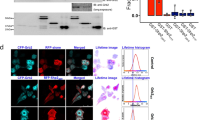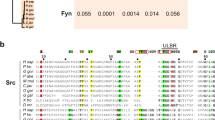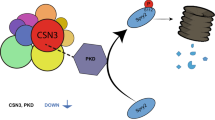Abstract
The Src family of protein tyrosine kinases (Src-PTKs) is important in the regulation of growth and differentiation of eukaryotic cells. The activity of Src-PTKs in cells of different types is negatively controlled by Csk, which specifically phosphorylates a conserved regulatory tyrosine residue at the carboxy-terminal tail of the Src-PTKs1,2,3. Csk is mainly cytoplasmic and Src-PTKs are predominantly membrane-associated. This raises a question about the mechanism of interaction between these enzymes. Here we present Cbp—a transmembrane phosphoprotein that is ubiquitously expressed and binds specifically to the SH2 domain of Csk. Cbp is involved in the membrane localization of Csk and in the Csk-mediated inhibition of c-Src. In the plasma membrane Cbp is exclusively localized in the GM1 ganglioside-enriched detergent-insoluble membrane domain, which is important in receptor-mediated signalling4,5,6,7,8. These findings reveal Cbp as a new component of the regulatory mechanism controlling the activity of membrane-associated Src-PTKs.
This is a preview of subscription content, access via your institution
Access options
Subscribe to this journal
Receive 51 print issues and online access
$199.00 per year
only $3.90 per issue
Buy this article
- Purchase on Springer Link
- Instant access to full article PDF
Prices may be subject to local taxes which are calculated during checkout





Similar content being viewed by others
References
Nada,S., Okada,M., MacAuley,A., Cooper,J. A. & Nakagawa, H. Cloning of a complementary DNA for a protein-tyrosine kinase that specifically phosphorylates a negative regulatory site of p60c-src. Nature 351, 69– 72 (1991).
Nada,S. et al. Constitutive activation of Src family kinases in mouse embryos that lack Csk. Cell 73, 1125– 1135 (1993).
Brown,M. T. & Cooper,J. A. Regulation, substrates and function of src. Biochem. Biophys. Acta 1287, 121 –149 (1996).
Simons,K. & Ikonen,E. Functional rafts in cell membranes. Nature 387, 569–572 (1997).
Brown,D. A. & London,E. Functions of lipid rafts in biological membranes. Annu. Rev. Cell. Dev. Biol. 14, 111–136 (1998).
Anderson,R. G. The caveolae membrane system. Annu. Rev. Biochem. 67 , 199–225 (1998).
Xavier,R., Brennan,T., Li,Q., McCormack,C. & Seed,B. Membrane compartmentation is required for efficient T cell activation. Immunity 8, 723– 732 (1998).
Montixi,C. et al. Engagement of T cell receptor triggers its recruitment to low-density detergent-insoluble membrane domains. EMBO J. 17, 5334–5348 (1998).
Howell,B. W. & Cooper,J. A. Csk suppression of Src involves movement of Csk to sites of Src activity. Mol. Cell. Biol. 14, 5402–5411 (1994).
Sabe,H., Hata,A., Okada,M., Nakagawa,H. & Hanafusa, H. Analysis of the binding of the Src homology 2 domain of Csk to tyrosine-phosphorylated proteins in the suppression and mitotic activation of c-Src. Proc. Natl Acad. Sci. USA 91, 3984–3988 (1994).
Cloutier,J. F., Chow,L. M. & Veillette, A. Requirement of the SH3 and SH2 domains for the inhibitory function of tyrosine protein kinase p50csk in T lymphocytes. Mol. Cell. Biol. 15, 5937– 5944 (1995).
Zhang,W., Sloan-Lancaster,J., Kitchen, J., Trible,R. P. & Samelson,L. E. LAT: the ZAP-70 tyrosine kinase substrate that links T cell receptor to cellular activation. Cell 9, 83–92 (1998 ).
Zhang,W., Trible,R. P. & Samelson, L. E. LAT palmitoylation: its essential role in membrane microdomain targeting and tyrosine phosphorylation during T cell activation. Immunity 9, 239–246 (1998).
Hanke,J. H. et al. Discovery of a novel, potent and Src family selective protein tyrosine kinase inhibitor. J. Biol. Chem. 271, 695–701 (1996).
Nada,S., Okada,M., Aizawa,S. & Nakagawa,H. Identification of major tyrosine-phosphorylated proteins in Csk-deficient cells. Oncogene 9, 3571–3578 ( 1994).
Tsuda,M. et al. Integrin-mediated tyrosine phosphorylation of SHPS-1 and its association with SHP-2. Roles of Fak and Src family kinases. J. Biol. Chem. 273, 13223–13229 (1998).
Harder,K. W., Moller,N. P., Peacock,J. W. & Jirik,F. R. Protein-tyrosine phosphatase alpha regulates Src family kinases and alters cell-substratum adhesion. J. Biol. Chem. 273, 31890–31900 (1998).
Hakak,Y. & Martin,G. S. Ubiquitin-dependent degradation of active Src. Curr. Biol. 9, 1039– 1042 (1999).
Kobayashi. S., Okumura,N., Okada,M. & Nagai,K. Depolarization-induced tyrosine phosphorylation of p130cas. J. Biochem. (Tokyo) 123, 624–629 ( 1998).
Jensen,O. N., Wilm,M., Shevchenko,A. & Mann,M. in Methods in Molecular Biology Vol. 112 (ed. Link, A. J.) 513– 530 (Humana, Totowa, 1999).
Harlow,E. & Lane,D. in Antibodies, a Laboratory Manual 359–420 (Cold Spring Harbor Laboratory, 1988).
Acknowledgements
We thank Y. Yoshimura and S. Norioka for peptide sequence analysis; S. Yoshimura and S. Aimoto for peptide synthesis; K. Nakamura and H. Sabe for technical advice; Y. Takayama and T. Hirose for production of recombinamt Csk in Sf9 cells; and C. Schmedt for critical comments. This work was supported by the Ministry of Education, Science, Sports and Culture of Japan and the Program for Promotion of Fundamental Studies in Health Sciences of the Organization for Pharmaceutical Safety and Research. A.T. was supported by the Deutsche Forschungsgemeinschaft and the Fonds der Chemie.
Author information
Authors and Affiliations
Corresponding authors
Rights and permissions
About this article
Cite this article
Kawabuchi, M., Satomi, Y., Takao, T. et al. Transmembrane phosphoprotein Cbp regulates the activities of Src-family tyrosine kinases. Nature 404, 999–1003 (2000). https://doi.org/10.1038/35010121
Received:
Accepted:
Issue Date:
DOI: https://doi.org/10.1038/35010121
This article is cited by
-
SH3-domain mutations selectively disrupt Csk homodimerization or PTPN22 binding
Scientific Reports (2022)
-
Inhibiting ACK1-mediated phosphorylation of C-terminal Src kinase counteracts prostate cancer immune checkpoint blockade resistance
Nature Communications (2022)
-
New roles for B cell receptor associated kinases: when the B cell is not the target
Leukemia (2019)
-
Role and mechanism of action of leucine-rich repeat kinase 1 in bone
Bone Research (2017)
-
Fer tyrosine kinase oligomer mediates and amplifies Src-induced tumor progression
Oncogene (2016)
Comments
By submitting a comment you agree to abide by our Terms and Community Guidelines. If you find something abusive or that does not comply with our terms or guidelines please flag it as inappropriate.



